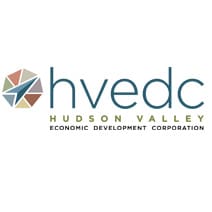Nearly 300 attendees pack Nelly Goletti Theatre at Marist College for HVEDC’s latest Thought Leaders Master Series program
NEW WINDSOR, N.Y. (March 24, 2017) — Nearly 300 business executives and community leaders participated in the Hudson Valley Economic Development Corp.’s (HVEDC) latest Thought Leaders Master Series program, the 2nd Annual EDs & MEDs Summit: Room to Grow at the Nelly Goletti Theatre at Marist College. The Summit highlighted how rapidly evolving medical technology is changing the health care industry – and innovative entrepreneurs and business owners are creating new business opportunities that will likely change the industry for the long term.
“This technology is moving seamlessly from the classroom to the examining room to the bedroom, with many experts foreseeing numerous opportunities to receive enhanced care without leaving their homes, reducing the patients’ need to return to the hospital,” said Laurence P. Gottlieb, HVEDC president and CEO.
With all these changes occurring so quickly, it will be critically important for public and private high schools, community colleges and universities to invest in programs, instructors, advanced technology and new teaching methodologies that will shape the next generation of health care professionals, Gottlieb said.
The Hudson Valley is home to many innovative health care organizations at all levels of the spectrum – from smaller home health care agencies to massive regional campuses – and their collective, positive impact on the area economy will be felt for years to come. Knowing that, Room to Grow featured a panel discussion that included industry leaders from the regional health care community. Those included colleges and universities, home health care providers and other key partners, so attendees could gain insights from many different facets.
They shared their insights on how critical regional community colleges and major four-year institutions will continue to serve as the backbone of the health care industry, despite the challenges posed by changes in technology and the profession overall.
Representatives from several health care providers focused on making for a more seamless transition between the hospital room to the home for patients, ensuring that both the initial handoff and short- and long-term care is as efficient and effective as possible. Because care is becoming increasingly accessible from one’s home, the location where people interact with the health care sector is changing in substantial ways.
Health care providers are also dealing with these changes, incorporating more technology and emerging best practices to improve the level and efficiency of care they deliver to their patients. These changes are impacting organizations from the bottom up, influencing their hiring processes, employee training and the background and training they look for in new hires. This all amounts to significant investments that go beyond technology and affect nearly every aspect of a hospital or clinic’s operations.
Panelists spoke about the importance of technology in daily operations and how evolving technology requires them to remain in the forefront of change.
• “Today, it’s so critical to have a bias in finding talent that understand innovation and doing things differently,” said Joseph DiCarlo, MBA, senior vice president and director of human resources at WESTMED Practice Partners. “There’s two words I share with new hires: Being nice and being smart. We define ‘smart’ as no matter what your role is, do you approach your job with how to do things differently? That’s what’s valued. The status quo is unacceptable.”
• “Community colleges are very critical in providing the workforce for a traditional medical model workforce,” said Pamela Edington, EdD, president at SUNY Dutchess. “We are the first step in their medical practice journey. And when it comes to technology, the answer is through partnership and collaboration.”
• “You see patients who fall through the cracks and have bad outcomes,” said Virginia Feldman, MD, CEO and co-founder at Nexus Health Resources. “With the Affordable Care Act, it’s about what’s spent and it’s about making sure patients don’t fall through the cracks. We can help do this with technology. The continuum of care needs to be a larger continuum. We want to decrease the total spent and have all patients be in the most comfortable surroundings.”
• “We’re looking at all technologies we can provide to support the patient at home,” said Mary Gadomski, Director of Business Development at Visiting Nurse Services in Westchester. “People are waking up to home care and how important home care will be in the future. We need nurses who have critical thinking skills. We look for that individual who is self-directed and we support them with technology.”
• “We’re not replacing clinical training, we’re augmenting it with technology,” said Kathleen S. Lill, MS, PA-C, director of Marist’s Physician Assistant Program, noting the many electronic platforms used by the college. “If the community is comfortable with our technology, our students will be comfortable with using theirs. There are so many possibilities.”
• “Our entire medical school is built on technology,” said Kenneth Steier, DO, executive dean and chief academic officer at TouroCOM-New York, who provided examples of the college’s 3D anatomy systems and robotic patients. “We can create just about any medical emergency with technology. The students are so technically based and oriented. It’s all about technology and I know our students will be ready for it.”
• “Will we be repurposing workers or developing a whole, new class of workers?” said Kristine Young, EdD, president at SUNY Orange. “Navigators and telehealth keep coming up. IT’s hard for community college to get out ahead of the curve but we want to be responsible for the changing needs of the community.”
• “Some of our challenges are trying to predict where technology is going what it will look like 10 to 15 years from now,” said Robert Friedberg, President & CEO of Health Quest. “We also spend a lot of time and energy figuring out how to put information into our systems. But our ability to extract it is limited. The most important opportunity we have is how do we use that information? That’s the challenge we’re all experiencing today.”
Room to Grow also featured keynote speaker Michael Dunn, senior vice president, Innovation Development, Georgia Pacific (GP). GP is developing devices to monitor hygienic practices at hospitals and clinics. Dunn explained how predictive analysis will impact the future of the industry, with companies like GP combining and examining data to predict consumer needs and provide more effective alerts to the public when a health outbreak is imminent.
Dunn reinforced that trends like mobile health, economies of scale, drive-through health care, hand hygiene compliance, consumerism and automation of care will be main drivers in the provision of care. Apps and connected devices will be used to deliver data that will be used to improved healthcare security, safety and wellness. Expanded beyond that are wearable devices like Google Project Jacquard, “e-skin” apparel like Xenoma and even watch-like devices like Heartisans, which uses algorithms to predict cardiac arrest.
“It’s about being smart and understanding the data and knowing how to use it,” said Dunn, noting augmented and virtual reality is becoming of age. “What are the things you need to be prepared for? And all the data becomes available using analytics and the cloud.”
“At HVEDC, we’ve recognized an opportunity to approach these important issues from a business perspective,” Gottlieb said. “The bottom line is that health care is changing – and what the industry looks like five or 10 years from now will be very different from what we are seeing today. Health care organizations and postsecondary institutions will need to make key investments to keep pace with the technological advancements that are happening now and will continue to take shape in the coming decade. There are business opportunities, and today’s event provided an interactive forum upon which we can evolve those discussions into action.”
About Hudson Valley Economic Development Corporation (HVEDC):
HVEDC is the leading economic development agency for the seven-county region of Westchester, Putnam, Dutchess, Rockland, Orange, Ulster and Sullivan counties. The public-private partnership markets the region as a prime business location to corporate executives, site selection consultants and real estate brokers. HVEDC helped start the organizational, branding and promotional effort for NY BioHud Valley, Hudson Valley 3D Printing, Hudson Valley EDs & MEDs and the Hudson Valley Food & Beverage Alliance. To learn more, call 845-220-2244 or visit hvedc.com.




